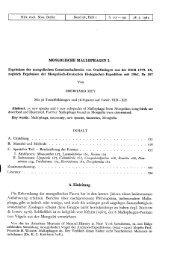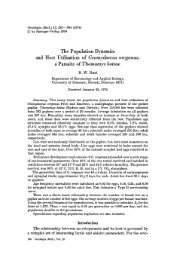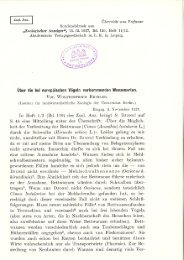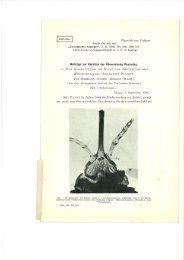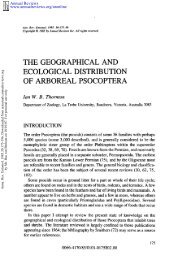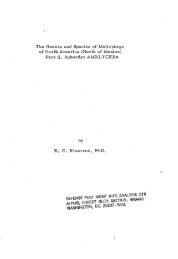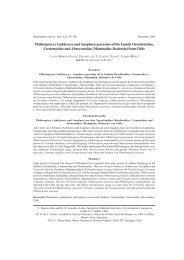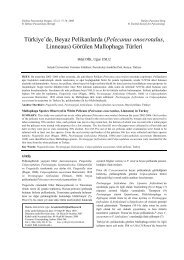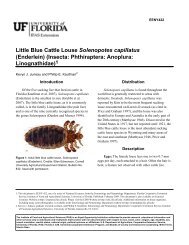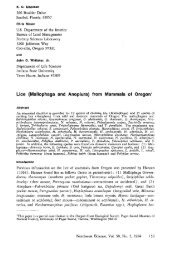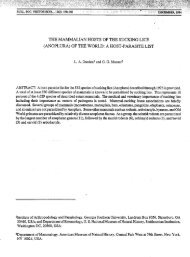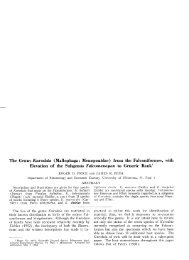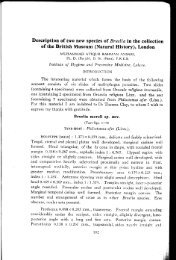pediculosis corporis; an updating of attitudes - Phthiraptera
pediculosis corporis; an updating of attitudes - Phthiraptera
pediculosis corporis; an updating of attitudes - Phthiraptera
Create successful ePaper yourself
Turn your PDF publications into a flip-book with our unique Google optimized e-Paper software.
<strong>an</strong> Updating <strong>of</strong> Attitudes<br />
J.W. Maunder, Department <strong>of</strong> Entomology.<br />
London School <strong>of</strong> Hygiene & Tropical Medicine<br />
INTRODUCTION<br />
In adv<strong>an</strong>ced countries clothing lice are <strong>of</strong>ten perceived as being<br />
more monstrous <strong>an</strong>d disgusting th<strong>an</strong> they really are. Parallel distortions<br />
occur in the way in which vagr<strong>an</strong>ts (the usual hosts) are<br />
seen, again being regarded with exaggerated disgust. In both<br />
cases the underlying emotion is fear. This needs guarding against,<br />
for, on the one h<strong>an</strong>d, <strong>an</strong> unadmitted fear <strong>of</strong> vagr<strong>an</strong>ts <strong>an</strong>d the<br />
down-<strong>an</strong>d-out may lead to unnecessarily harsh treatment <strong>of</strong><br />
them, while, on the other h<strong>an</strong>d, a subconscious fear <strong>of</strong> lice may<br />
lead to exaggerated or illogical control measures being employed.<br />
In our society it is impossible to sustain clothing lice for more<br />
th<strong>an</strong> a few days unless a considerable departure from normally<br />
accepted st<strong>an</strong>dards <strong>of</strong> hygiene <strong>an</strong>d self-care has occurred. This<br />
provides the clue to effective treatment, which must always aim<br />
at the restoration <strong>of</strong> normal hygienic st<strong>an</strong>dards <strong>of</strong> life. The killing<br />
<strong>of</strong> the insects is only <strong>an</strong> adjunct to the care <strong>of</strong> the individual carrying<br />
them.<br />
A Disease<br />
The mere possession <strong>of</strong> clothing lice constitutes a disease,<br />
<strong>pediculosis</strong> <strong>corporis</strong>, the infective agent being Pedj’cu.lus hum<strong>an</strong>us<br />
hum<strong>an</strong>us, the hum<strong>an</strong> clothing louse. The course <strong>of</strong> the disease<br />
maybe divided into three parts: <strong>an</strong> incubation period, followed<br />
first by primary <strong>an</strong>d later by secondary sensitisation. When the<br />
body is first invaded by lice the process is quite symptomless,<br />
unless <strong>an</strong> occasional tickle caused by a louse moving on the skin<br />
may be classed as a symptom. Each louse feeds by sucking blood<br />
from its host four or five times each day. The skin is pierced with<br />
the long delicate mouthparts which normally lie hidden from<br />
view in a housing running the length <strong>of</strong> the head. During the<br />
incubation period the bites are quite painless, leave no mark <strong>an</strong>d<br />
cause no reaction.<br />
However, into the bite wounds the lice inject a relatively large<br />
volume <strong>of</strong> saliva. It is a mixture <strong>of</strong> blood <strong>an</strong>d saliva which is<br />
drawn up by the lice. This saliva contains <strong>an</strong> <strong>an</strong>ti-coagul<strong>an</strong>t to<br />
prevent the blood from clotting in the insects’ own feeding tubes.<br />
It also contains a red-cell clumping agent, various digestive<br />
enzymes <strong>an</strong>d, by <strong>an</strong>alogy with other blood-sucking insects, probably<br />
a local <strong>an</strong>aesthetic.<br />
Also, as the insects increase in number, so does the total <strong>of</strong> bites<br />
sustained. The presence <strong>of</strong> 200 lice in the clothing, a moderately<br />
heavy infection, will result m approximately 1,000 bites each<br />
day. Thus a signific<strong>an</strong>t qu<strong>an</strong>tity <strong>of</strong>biologically active protein will<br />
be injected through the skin on a regular basis, day by day. It is<br />
against this that the body eventually reacts,<br />
Hum<strong>an</strong> beings vary very much in their response to sensitising<br />
proteins. As few as 10,000 louse bites may be enough to induce<br />
primary sensitisation in some individuals, others may require as<br />
m<strong>an</strong>y as 100,000 bites. In general such levels are attained three to<br />
eight months after the original infection with lice, when the<br />
primary, local, sensitisalion develops.<br />
From this point on, bitten areas begin to itch. This is usually<br />
most uncomfortable; sleep is disturbed <strong>an</strong>d scratching may lead<br />
to secondary bacterial infection. (Following a cure, <strong>an</strong>y subsequent<br />
louse infection may begin to itch at once, for the primary<br />
sensitisation is retained, resulting in <strong>an</strong> incubation period which<br />
is shorter or absent).<br />
The literature contains m<strong>an</strong>y inst<strong>an</strong>ces <strong>of</strong> failure to appreciate<br />
the import<strong>an</strong>ce <strong>of</strong>, or even the exist<strong>an</strong>ce <strong>of</strong>, sensitisation<br />
phenomena. For example, Moore <strong>an</strong>d Hirschfelder, in 1919, correctly<br />
described the results <strong>of</strong>heavy louse biting, choosing as subjects<br />
people who were used to being bitten. Buxton, in 1947,,<br />
dismissed this evidence on the grounds that biting experienced by<br />
himself <strong>an</strong>d his associates caused little reaction. With the benefit<br />
<strong>of</strong> hindsight we c<strong>an</strong> be sure that the middle class volunteers concerned<br />
had been insufficiently bitten on previous occasions to<br />
have developed sensitivity. Individual variation is illustrated by<br />
one <strong>of</strong> Buxton’s associates, now Pr<strong>of</strong>essor J.R. Busvine, who<br />
went on to feed very large numbers <strong>of</strong> lice on himself over m<strong>an</strong>y<br />
years without developing more th<strong>an</strong> a low degree <strong>of</strong> sensitisation.<br />
On the other h<strong>an</strong>d, I myself, <strong>an</strong>d several associates, have become<br />
so sensitised as a result <strong>of</strong> experimental louse feeding as to be able<br />
to testify that to a sensitive individual even a few dozen bites a day<br />
are a most unpleas<strong>an</strong>t experience,<br />
Worse is in store for the long-term lousy person. Secondary<br />
sensitisation develops approximately twelve to eighteen months<br />
after infection with lice. A general <strong>an</strong>d systemic reaction now<br />
occurs. The patient may run a slight temperature; muscular aches<br />
<strong>an</strong>d pains start, especially in the feet <strong>an</strong>d legs; a short-lived rash<br />
resembling Germ<strong>an</strong> measles <strong>of</strong>ten forms; a dull <strong>an</strong>d pessimistic<br />
frame <strong>of</strong> mind develops, <strong>an</strong>d the person becomes apathetic if left<br />
alone <strong>an</strong>d irritable if roused. Such a person is not well, in fact he<br />
feels lousy, presumably the origin <strong>of</strong> the phrase. People do not<br />
merely have lice, they also suffer from them.<br />
Unfortunately much <strong>of</strong> the malaise <strong>of</strong> <strong>pediculosis</strong> is <strong>of</strong>ten<br />
wrongly ascribed to mental deficiency, alcoholism, vitamin<br />
deficiency or depression, although, <strong>of</strong> course, one or more <strong>of</strong><br />
these conditions may also be concurrently present,<br />
Complications may yet occur. Prolonged heavy biting may<br />
result in areas <strong>of</strong> skin becoming perm<strong>an</strong>ently hardened <strong>an</strong>d<br />
darkened, the condition known as morbus errorum. Some sufferers<br />
become allergic to the faeces <strong>of</strong> the lice, developing a condition<br />
similar to hay fever. (This is, in particular, a hazard <strong>of</strong><br />
laboratory workers h<strong>an</strong>dling lice.)<br />
Difficulties attend the diagnosis <strong>of</strong> <strong>pediculosis</strong>. M<strong>an</strong>y cases are<br />
light, due either to short duration or to the <strong>an</strong>ti-louse activities <strong>of</strong><br />
the host. The average infection involves rather less th<strong>an</strong> 100<br />
insects <strong>an</strong>d these, grey in colour <strong>an</strong>d preferring to secrete themselves<br />
in seams <strong>of</strong> clothing, are easily missed, especially as they<br />
are largely found in underclothing, which is, (or was.’), predomin<strong>an</strong>tly<br />
white in colour.<br />
M<strong>an</strong>y persons with lice will make the effort to ch<strong>an</strong>ge’their<br />
clothing, especially underwear, if a visit to the doctor is<br />
necessary. Actual lice rarely appear in the surgery, but elongated<br />
bitten areas on the body, <strong>of</strong>ten following the outline <strong>of</strong> the seams<br />
<strong>of</strong> <strong>an</strong> undervest or other clothing, provide <strong>an</strong> indication <strong>of</strong> the presence<br />
<strong>of</strong> lice. Emergency clinics see them much more frequently.<br />
ACTION<br />
When a lousy person undresses, or is undressed, the viable lice<br />
will stay in the clothing rather th<strong>an</strong> on him. Any insects dropping<br />
out onto the floor, or remaining on the patient, are <strong>of</strong> little<br />
signific<strong>an</strong>ce. These are the senile, injured, sick or dead lice, or<br />
else merely the cast skins shed by the insects as they grow. Lice<br />
are only mortal, <strong>an</strong>d their bodies must go somewhere!<br />
Lousy clothing may be safely h<strong>an</strong>dled provided that a few<br />
minimal precautions are taken. In bright light the insects will not<br />
tr<strong>an</strong>sfer to a new host, preferring to crouch motionless, <strong>of</strong>ten in<br />
seams, attempting to escape detection. Care should be taken not<br />
to allow the lousy clothing to touch the h<strong>an</strong>dler’s own. The special<br />
tight-fitting protective clothing which used to be recommended is<br />
not really necessary, nor is it very effective, although some form<br />
<strong>of</strong> washable or disposable outer garment is obviously desirable<br />
for other reasons. White is the best colour; lice will avoid making
themselves conspicuous.<br />
Having separated the lousy person from his or her clothing the<br />
problem is resolved into two parts: what to do with the person,<br />
<strong>an</strong>d what with the clothing. The first is a medical <strong>an</strong>d social problem,<br />
the second may now be thought <strong>of</strong> as environmental.<br />
Treatment<br />
The treatment <strong>of</strong> lousy people must not contain <strong>an</strong>y punitive element.<br />
Influenced by deep-seated fear <strong>of</strong> the parasites, kindly <strong>an</strong>d<br />
intelligent people c<strong>an</strong> act in surprisingly irrational <strong>an</strong>d even cruel<br />
fashion towards the lousy, without being properly aware or’thew<br />
own motivation. The old, grim Victori<strong>an</strong> disinfestation centres,<br />
staffed by unqualified attend<strong>an</strong>ts, acting more as warders th<strong>an</strong> as<br />
nurses, lingered on too long; nor were they altogether effective.<br />
for suchwas the humiliation involved that lousy people <strong>of</strong>ten preferred<br />
to keep their lice as long as possible.<br />
Str<strong>an</strong>gely, few destitute people see themselves as tramps or<br />
vagr<strong>an</strong>ts. In their own eyes they are simply suffering a period <strong>of</strong><br />
bad’luck. They may retain more hum<strong>an</strong> dignity <strong>an</strong>d self respect<br />
th<strong>an</strong> is externally visible, <strong>an</strong>d these need fostering <strong>an</strong>d supporting.Punitive<br />
measures are inappropriate.<br />
Clinics treating <strong>pediculosis</strong> <strong>corporis</strong> should ideally be part <strong>of</strong><br />
larger multi-pr<strong>of</strong>essional medical centres where the advice <strong>of</strong><br />
doctors, social workers <strong>an</strong>d even chiropodists or dentists is<br />
immediately available. Lousiness may be the presenting symptom,<br />
but it is unlikely to be the sole one. Delousing is only a starting<br />
point, not <strong>an</strong> end.<br />
Clinics should be in the charge <strong>of</strong> a person suitably qualified for<br />
the recognition <strong>an</strong>d treatment <strong>of</strong> the various ectoparasitic diseases<br />
<strong>an</strong>d with sufficient medical knowledge to recognise when a<br />
doctor’s advice is needed, A senior qualified nurse, male or<br />
female as appropriate, is the most likely choice, but other<br />
qualifications are possible. The appointment <strong>of</strong> other staff needs<br />
great care. Patience <strong>an</strong>d good humour are essential, combined<br />
with the ability to be firm as necessary, but the types <strong>of</strong> firmness<br />
displayed by policemen, army serge<strong>an</strong>ts <strong>an</strong>d prison <strong>of</strong>ficers,<br />
however praiseworthy in their own contexts, are quite unacceptable<br />
in this situation. Rather, the brisk no-nonsense kindliness <strong>of</strong><br />
a good schoolmaster is needed.<br />
Staff at all levels c<strong>an</strong>not be expected to perform their duties<br />
without training. Close supervision is also needed; experience<br />
has shown that this is <strong>an</strong> area where harshness, hectoring <strong>an</strong>d<br />
even bullying c<strong>an</strong> insidiously invade what ought to be a caring<br />
service.<br />
The clinic premises should be sufficientlywarm. People suffering<br />
from poor nutrition feel the cold more intensely. Washable<br />
cork or composition floors, warm to the touch, must be provided<br />
<strong>an</strong>d chairs <strong>an</strong>d benches should also not feel cold,<br />
Adequate attention must be paid to the privacy <strong>an</strong>d dignity <strong>of</strong><br />
the patients. Cubicles or screens <strong>of</strong> some kind are needed, for noone<br />
should be expected to undress with other patients watching.<br />
Washable or disposable gowns need to be provided for each person.<br />
The former humiliating practice <strong>of</strong> leaving patients st<strong>an</strong>ding.<br />
naked while their clothing was dealt with was a cruelty which<br />
must never be allowed today.<br />
The bath is <strong>an</strong> optional extra. Patients have <strong>an</strong> absolute right to<br />
refuse it, <strong>an</strong>d staff training must emphasise that lousiness <strong>an</strong>d dirtiness<br />
are two separate problems. Both may be symptoms <strong>of</strong><br />
neglect, but they are not otherwise related. Taking a bath as such<br />
does nothing to cure lice <strong>an</strong>d therefore is not part <strong>of</strong> the treatment.<br />
Nevertheless, it should be encouraged as a service, as <strong>an</strong> agreeable<br />
thing to do, <strong>an</strong>d because to be cle<strong>an</strong> helps self respect. (A<br />
ENVIRONMENTAL HEALTH MAY 1983<br />
compulsory bath does not aid self respect; rather the opposite.)<br />
There is a world <strong>of</strong> difference between making someone do a good<br />
thing <strong>an</strong>d encouraging them to do it for themselves,<br />
It is unlikely that <strong>an</strong>y viable clothing lice will remain on the<br />
body after undressing, but other conditionsmay be present. A few<br />
clothing louse eggs are occasionally found on body hair, but most<br />
<strong>of</strong> such claims are really due to confusion with the eggs <strong>of</strong>the crab<br />
louse. The body hair <strong>of</strong> both sexes <strong>an</strong>d the beards <strong>an</strong>d head hair <strong>of</strong><br />
men may contain crab lice <strong>an</strong>d their eggs. The practice <strong>of</strong> clipping<br />
body hair is quite unnecessary. The head hair <strong>of</strong>women may contain<br />
head lice, but this louse is rare on the heads <strong>of</strong> adult men.<br />
Scabies may be present in either sex.<br />
Diagnosis <strong>an</strong>d treatment <strong>of</strong> all these conditions c<strong>an</strong>not be left to<br />
unqualified or untrained staff. In general, insecticidal lotions are<br />
to be preferred to powders, which have <strong>an</strong> insufficiently intimate<br />
contact with louse eggs, or to shampoos, which are left on too<br />
short a time to be fully effective. If only clothing lice are present,<br />
insecticides are generally superfluous; nothing is more import<strong>an</strong>t<br />
th<strong>an</strong> the restoration <strong>of</strong> regular ch<strong>an</strong>ges <strong>of</strong> clothing.<br />
Social Workers<br />
Social workers involved with <strong>pediculosis</strong> <strong>corporis</strong> should be<br />
aware that although clothing lice are associated with abject<br />
poverty <strong>an</strong>d with vagr<strong>an</strong>ts <strong>an</strong>d refugees, this is not because they<br />
are poor or dirty or homeless as such, but because they are using<br />
only one set <strong>of</strong> clothing. Anyone who possesses only one set <strong>of</strong><br />
clothes, or, owning more, does not ch<strong>an</strong>ge, runs the risk <strong>of</strong><br />
<strong>pediculosis</strong>. If two sets <strong>of</strong> clothing are in rapid alternate use, then<br />
two sets <strong>of</strong> lice c<strong>an</strong> be kept. However, <strong>an</strong>yone who ch<strong>an</strong>ges between<br />
two sets <strong>of</strong> clothing regularly, never keeping one set on for<br />
more th<strong>an</strong> twelve days or for less th<strong>an</strong> five, c<strong>an</strong>not keep lice no<br />
matter how dirty or otherwise unhygienic he may be. It has been<br />
suggested that this is the origin <strong>of</strong> the week,<br />
The first aim <strong>of</strong> the social worker, then, must be to ensure that<br />
patients newly cured <strong>of</strong> lice possess two sets <strong>of</strong> clothing. Then, if<br />
possible, provision needs to be made for, <strong>an</strong>d the patient<br />
encouraged to make, regular ch<strong>an</strong>ges <strong>of</strong> clothes. This usually<br />
implies provision <strong>of</strong> some kind <strong>of</strong> home, but this may be difficult.<br />
Our society does not do enough for the single homeless<br />
person.<br />
If the lousy person is also otherwise ill, special care may be<br />
needed in his treatment. This is particularly true <strong>of</strong> those who are<br />
brought to casualty <strong>an</strong>d emergency clinics following accidents or<br />
sudden illness. The presence <strong>of</strong> lice in such a person’s clothing<br />
c<strong>an</strong> sometimes induce a literal p<strong>an</strong>ic in those who.discover them.<br />
M<strong>an</strong>y a good nurse, who would devotedly tend persons suffering<br />
from d<strong>an</strong>gerous infectious illness, c<strong>an</strong>not bring herselfto as much<br />
as touch the lousy. If a seriously entomophobic person is in<br />
charge, the patient may be in actual d<strong>an</strong>ger. Cases are recorded <strong>of</strong><br />
hospital staff dressing themselves up in protective clothing, donning<br />
rubber gloves <strong>an</strong>d thoroughly scrubbing the patient with<br />
soap, disinfect<strong>an</strong>ts, benzyl benzoate <strong>an</strong>d powerful insecticides,<br />
regardless <strong>of</strong> what other medical condition he may be in. All too<br />
<strong>of</strong>ten the result is a very sweet smelling but very dead tramp, for<br />
m<strong>an</strong>y <strong>of</strong> these people are in no fit state to st<strong>an</strong>d such treatment.<br />
Better that a vagr<strong>an</strong>t with, say, a coronary, should keep both his<br />
lice <strong>an</strong>d his life until he is fit enough for gentle removal <strong>of</strong> his<br />
clothing <strong>an</strong>d forwashing. It is not in the patient’s best interest that<br />
we should be afraid <strong>of</strong> him for no other reason th<strong>an</strong> that he is a<br />
tramp, nor that we should over-react to his lousiness.<br />
Infested clothing<br />
The treatment <strong>of</strong> infested clothing needs Just as much care <strong>an</strong>d
sensitivity as does the treatment <strong>of</strong> infected people. An overcoat<br />
which wouldbe thrown away at once by the average person might<br />
well be a vagr<strong>an</strong>t’s single most treasured possession. If it comes<br />
back from some steam disinfestor shrunken <strong>an</strong>d unwearable then<br />
a first class disaster will have occurred in that m<strong>an</strong>’s life.<br />
If lousy clothing is washed, all that is achieved is cle<strong>an</strong>er lice<br />
unless the water is hot enough to kill the lice. As a general guide, if<br />
the water is too hot for the h<strong>an</strong>ds to be put into it then the lice will<br />
be killed. If the water is cool enough for h<strong>an</strong>d washing then they<br />
will survive. The disadv<strong>an</strong>tages <strong>of</strong> delousing by hot-water washing<br />
are that the process is very slow <strong>an</strong>d somewhat expensive, <strong>an</strong>d<br />
also that m<strong>an</strong>y items <strong>of</strong> clothing, especially outer-wear, c<strong>an</strong>not be<br />
satisfactorily washed. The adv<strong>an</strong>tage is that clothing is returned<br />
very cle<strong>an</strong>.<br />
The old-fashioned steam steriliser is on its way out, if for no<br />
other reason th<strong>an</strong> excessive cost. Heat penetrates a static pile <strong>of</strong><br />
clothing very poorly, <strong>an</strong>d alternated applications <strong>of</strong> steam <strong>an</strong>d<br />
vacuum are needed. The vast size <strong>of</strong> some <strong>of</strong> these old pieces <strong>of</strong><br />
equipment gives a false impression <strong>of</strong> effectiveness. In fact,<br />
unless the operation is carried out most carefully, louse eggs will<br />
survive, for they are protected from excessive temperatures by<br />
being hidden in seams. Apart from expense, the disadv<strong>an</strong>tages<br />
include damage to clothing, especially buttons, zips <strong>an</strong>d other<br />
plastic components, slowness <strong>of</strong> operation <strong>an</strong>d the fact that the<br />
clothes are returned still dirty. Steam sterilisation has little to<br />
recommend it.<br />
Dry-cle<strong>an</strong>ing <strong>of</strong> clothes is effective against both lice <strong>an</strong>d eggs,<br />
On a large scale it becomes more economically justifiable. The<br />
disadv<strong>an</strong>tages are the comparatively high expense <strong>an</strong>d the fact<br />
that the clothes must be very well aired before return, which<br />
slows the process down. The adv<strong>an</strong>tages are that clothes are<br />
returned cle<strong>an</strong> <strong>an</strong>d that outer clothing c<strong>an</strong> be safely treated. The<br />
extra expense c<strong>an</strong> <strong>of</strong>ten’-be justified in terms <strong>of</strong> hum<strong>an</strong> happiness<br />
<strong>an</strong>d the encouragement to self respect, for a dry-cle<strong>an</strong>ed overcoat<br />
does much to raise morale. If it were more widely known that drycle<strong>an</strong>ing<br />
fluids are completely effective insecticides against<br />
clothing lice, then the process might be employed more widely for<br />
this purpose.<br />
The use <strong>of</strong> fumig<strong>an</strong>ts, for example methyl bromide or ethyl formate,<br />
if done properly, is as effective for killing lice as drycle<strong>an</strong>ing.<br />
The cost is less, but the clothing remains dirty, the<br />
treatment time is prolonged (several hours are needed), <strong>an</strong>d <strong>an</strong> airing<br />
period is still needed. Ethyl formate is the most effective compound,<br />
but constitutes a fire hazard. Well ventilated <strong>an</strong>d<br />
electrically safe areas are needed for its employment. Ethyl formate<br />
c<strong>an</strong> damage plastic components <strong>of</strong> clothing, especially ifthe<br />
liquid compound, instead <strong>of</strong> only the vapour, comes into contact<br />
with them.<br />
Methyl bromide is effective, not a fire hazard, is less damaging<br />
to clothing <strong>an</strong>d needs less airing, but is so toxic to m<strong>an</strong> that very<br />
careful training <strong>an</strong>d supervision must accomp<strong>an</strong>y its use. In particular<br />
the risk <strong>of</strong> accidental poisoning is high, for there are few<br />
warning signs or symptoms. At low temperatures, less th<strong>an</strong> 10C,<br />
fumigation loses much <strong>of</strong> its effectiveness.<br />
The newest development in the treatment <strong>of</strong> lousy clothing has<br />
been the introduction <strong>of</strong> dry tumble-drying, following a description<br />
by Maunder in 1977. Clothing is placed dry in a normal<br />
domestic or industrial tumble-dryer. Because dry clothing does<br />
not cool itself by evaporation <strong>of</strong> water, a temperature lethal to the<br />
louse is soon attained throughout the whole <strong>of</strong> the clothing. The<br />
old problems <strong>of</strong> poor heat penetration which placed such severe<br />
limitations on the efficiency <strong>of</strong> hot air ovens <strong>an</strong>d steam disinfectors<br />
are totally overcome.<br />
The temperatures necessary to kill lice are remarkably low<br />
once a method has been found to bring the heat to the insects.<br />
Buxton, 1940, gives the following minimum lethal temperatures:<br />
It is also known that even lower temperatures are effective if<br />
the humidity is low, as, <strong>of</strong> course, it would be in a dry tumbledryer.<br />
In practice it has been found that if a suitable machine is set to<br />
give a final exhaust temperature in excess <strong>of</strong> 60C, then even a<br />
domestic tumble dryer will kill all lice <strong>an</strong>d eggs inside fifteen<br />
minutes when the machine is started from cold. Before installing<br />
a machine for this purpose it is as well to check with the m<strong>an</strong>ufacturers<br />
as to the suitability <strong>of</strong> <strong>an</strong>y model.<br />
For clinic use it is best for the exhaust from the machine to be<br />
ch<strong>an</strong>nelled to the outside, for the dust from lousy clothing c<strong>an</strong> be<br />
irritating if breathed in, <strong>an</strong>d such dust will not be sterile. Any<br />
d<strong>an</strong>gers from this dust are no greater th<strong>an</strong> from shaking lousy<br />
clothing in a room, but if aesthetically <strong>an</strong>d hygienically undesirable<br />
for exhaust air to be vented indoors..<br />
The dry tumble-drying method has the adv<strong>an</strong>tages <strong>of</strong> low capital<br />
outlay, rapid turn-over <strong>of</strong> small batches <strong>of</strong> garments, little risk<br />
<strong>of</strong> damaging clothing <strong>an</strong>d high effectiveness. The clothing is<br />
returned dirty, but after this treatment it is safe to send it for conventional<br />
laundering if desired.<br />
CONCLUSION<br />
Pediculosis <strong>corporis</strong> is a disease, not as serious as the major louseassociated<br />
diseases such as typhus <strong>an</strong>d relapsing fever, but a disease<br />
nevertheless. Our updated <strong>attitudes</strong> call upon us to treat the<br />
condition as we would <strong>an</strong>y other, not fastening moral blame onto<br />
the sufferers to carry in addition to their lice <strong>an</strong>d their concommit<strong>an</strong>t<br />
problems. The lousy have enough to bear, <strong>an</strong>d they are only<br />
hum<strong>an</strong> too.<br />
Our fear <strong>of</strong> lice is largely quite illogical. Often if helps to stop<br />
<strong>an</strong>d look at a live louse for a while. The monster is then cut down<br />
to size, <strong>an</strong>d becomes just <strong>an</strong>other little insect.<br />
References<br />
Buxton, P.A. (1940]. The biology <strong>of</strong> the body louse underexperimental<br />
conditions. ParasitoJogy, 32, 303-312<br />
Buxton, P.A. (1947). The Louse. 2nd Ed. Edward Arnold<br />
(London].<br />
Maunder, J.W. [1977). Hum<strong>an</strong> lice biology <strong>an</strong>d control. Royal<br />
Society <strong>of</strong> Health Journal, 97, 29.<br />
Moore, W. <strong>an</strong>d Hirschfelder, A.D. (1919). An investigation <strong>of</strong> the<br />
louse problem. Research Publications <strong>of</strong> the University <strong>of</strong> Minnesota,<br />
8, 1-86.



